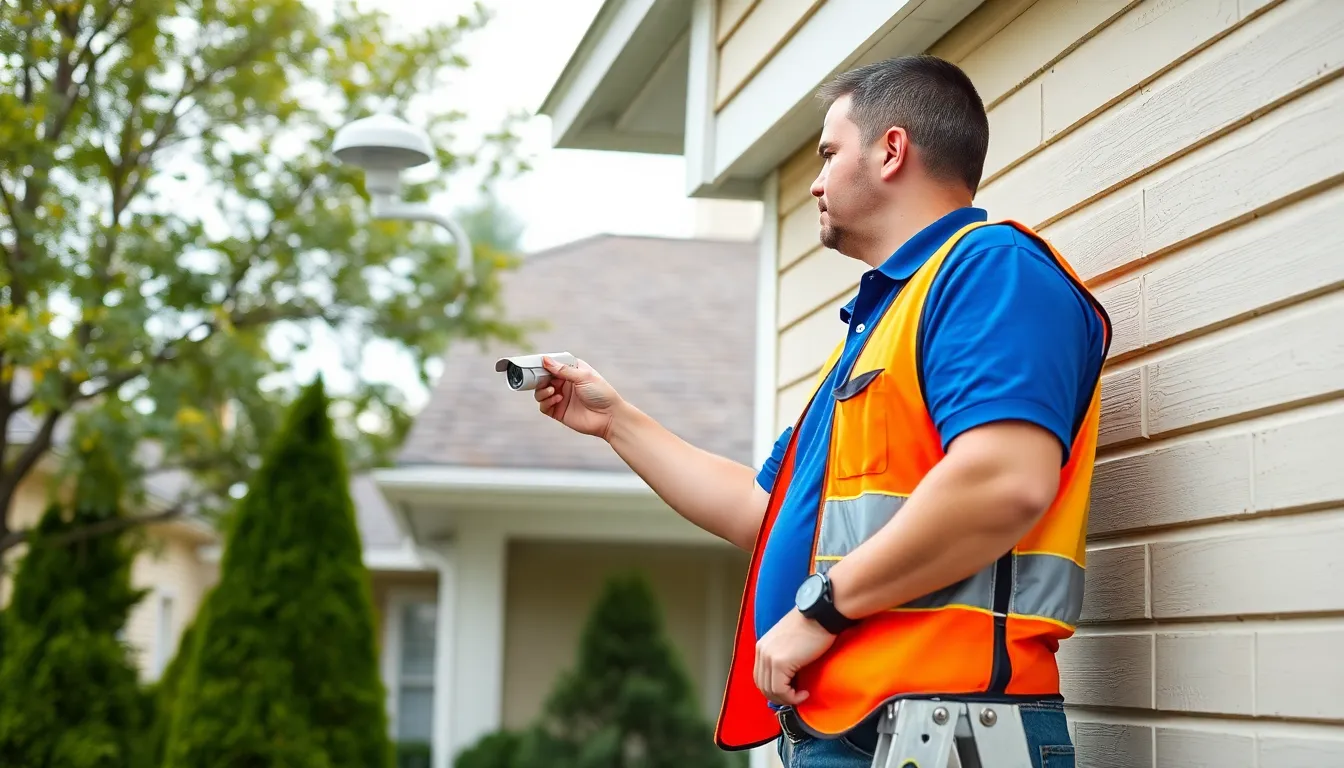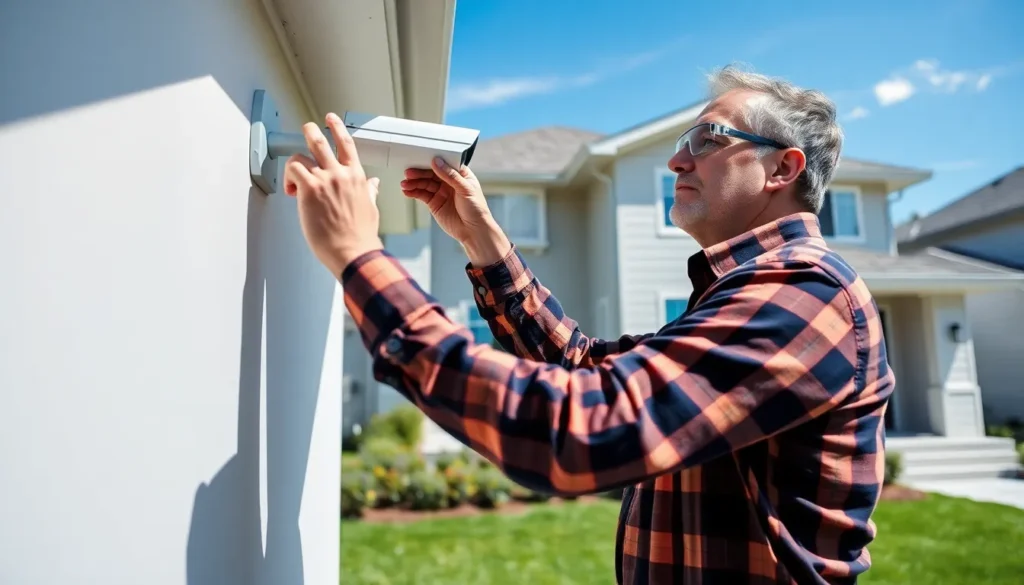Table of Contents
ToggleIn today’s world, ensuring safety and security has never been more crucial. With rising concerns over theft and vandalism, security camera installation has become a top priority for homeowners and businesses alike. These systems not only deter crime but also provide peace of mind, knowing that your property is under constant surveillance.
Choosing the right security camera and understanding the installation process can be overwhelming. From selecting the ideal locations to deciding between wired or wireless options, each step plays a vital role in maximizing effectiveness. This guide will simplify the process, offering insights into best practices for securing any space with confidence.
Understanding Security Camera Installation
Security camera installation plays a critical role in modern safety and security strategies. Properly placed cameras can significantly reduce crime rates while providing evidence when incidents occur.
Importance of Security Cameras
Security cameras are vital for several reasons. They deter criminal activity, promote a sense of safety, and assist in monitoring property. Studies indicate that homes and businesses with visible cameras experience lower theft rates compared to those without. Beyond deterrence, cameras offer valuable documentation. In the event of a crime, recorded footage can provide crucial evidence for law enforcement, helping resolve incidents efficiently.
Types of Security Cameras
Various types of security cameras exist, each suited to different needs.
- Dome Cameras: Commonly used in retail establishments, dome cameras blend into the environment. Their design prevents tampering and provides a wide field of view.
- Bullet Cameras: Known for their long-range capabilities, bullet cameras excel in outdoor spaces. They resist harsh weather conditions, making them ideal for perimeter monitoring.
- PTZ Cameras: Pan-Tilt-Zoom cameras allow remote control over the camera’s movement. Users can adjust the focus and direction, maximizing coverage and detail.
- IP Cameras: Internet Protocol cameras transmit footage over a network. They provide high-resolution images and enable remote viewing through smartphones or computers.
- Wireless Cameras: Wireless options simplify installation by eliminating the need for extensive wiring. They offer flexibility in placement, while connected apps facilitate real-time monitoring.
Selecting the appropriate camera type depends on specific security needs and the layout of the space. Each type serves distinct functions that enhance overall security efficiency.
Preparing for Security Camera Installation

Preparing for security camera installation involves understanding specific needs and determining optimal locations. Proper preparation ensures effective surveillance coverage and enhances overall security.
Assessing Your Security Needs
Assess security requirements by evaluating potential vulnerabilities. Identify areas with high foot traffic, possible entry points, and blind spots. Compile a list of concerns, such as theft, vandalism, or monitoring specific activities. Prioritize features like resolution, night vision, and recording capabilities based on the location’s environment. Engage with local law enforcement for insights on crime trends in the area, and utilize this information to inform decisions.
Choosing the Right Camera Location
Choose camera locations strategically to maximize coverage. Select high vantage points for wide-angle visibility, and ensure cameras aren’t easily tampered with. Position cameras near entrance points, driveways, and outdoor spaces where vehicles or packages may be present. Consider the field of view when placing cameras; cameras should capture entrances and exits without obstructions. Avoid direct sunlight and avoid pointing cameras toward reflective surfaces, to enhance image clarity and reduce glare. Use a combination of camera types to meet diverse monitoring needs, ensuring each camera serves a distinct purpose in the overall security strategy.
Steps for Security Camera Installation
Following a structured approach ensures a successful security camera installation. The process involves several steps, including gathering necessary tools, addressing wiring considerations, and properly mounting the cameras.
Tools and Equipment Needed
- Security Cameras: Select cameras based on specific needs and environment.
- Drill and Drill Bits: Use for creating holes for mounting brackets.
- Screwdrivers: Have both Philip’s and flathead screwdrivers for various screws.
- Cable Clips: Organize and secure wiring along walls to prevent tripping hazards.
- Fish Tape: Use for running cables through walls, making installation cleaner.
- Level: Ensure cameras are mounted straight for optimal coverage.
- Ladder: Access high locations safely during installation.
Wiring and Power Supply Considerations
- Cable Types: Utilize coaxial cables for analog cameras and Ethernet cables for IP cameras.
- Power Supply: Identify a reliable power source, ensuring consistent operation.
- PoE Technology: Consider Power over Ethernet (PoE) to streamline installation by combining data and power through one cable.
- Weatherproofing: Use weather-resistant cables and connectors for outdoor installations to protect against environmental elements.
- Voltage Requirements: Verify that the cameras match the power supply’s voltage specifications to avoid damage.
Mounting the Cameras
- Choosing Locations: Select areas with clear lines of sight, maximizing surveillance capabilities.
- Height: Mount cameras at least 9 feet above ground, reducing tampering risks while maximizing coverage.
- Angle: Position cameras to capture wide views and avoid blind spots, focusing on entry points and high-traffic areas.
- Secure Installation: Use appropriate mounting hardware and ensure cameras are firmly attached to prevent movement or displacement.
- Focus Adjustment: After mounting, adjust the camera angles for optimal coverage, ensuring field of view aligns with security needs.
Configuring Your Security Camera System
Configuring a security camera system is essential for its efficient operation. Proper setup ensures cameras function optimally, offering reliable coverage and effective monitoring.
Connecting to Wi-Fi
Connecting security cameras to Wi-Fi allows for remote access and real-time monitoring. Follow these steps for a successful connection:
- Select Your Camera: Choose a camera compatible with wireless networks.
- Power On: Turn on the camera and ensure it’s in pairing mode, often indicated by a blinking light.
- Use App: Download the camera’s companion app on a smartphone or tablet. Most manufacturers provide dedicated applications for easy setup.
- Follow Prompts: Open the app and follow the on-screen instructions to connect to your home Wi-Fi network. You will typically enter your network name and password.
- Test Connection: Once connected, test the live feed in the app to confirm a stable connection.
Maintaining strong Wi-Fi connectivity is crucial for consistent performance, so consider using range extenders in areas with weak signals.
Setting Up Security Features
Setting up security features maximizes the effectiveness of security camera systems. Key steps include:
- Activate Motion Detection: Enable motion detection features to receive alerts for any movement within the camera’s field of view.
- Adjust Sensitivity: Fine-tune detection sensitivity to minimize false alerts while ensuring important events trigger notifications.
- Set Recording Schedules: Choose to record continuously or on a schedule, allowing for tailored surveillance based on specific needs or times when property is vacant.
- Enable Notifications: Activate push notifications for immediate alerts to smartphones or emails when movement is detected.
- Secure Access: Implement secure passwords for camera access. Change default passwords to unique, strong ones to prevent unauthorized access.
These configurations provide enhanced security, ensuring cameras perform their roles effectively and offer peace of mind.
Maintenance and Troubleshooting
Maintaining security cameras ensures their reliability and longevity. Regular inspections help identify issues early, keeping systems functional and effective.
Regular Maintenance Tips
- Clean lenses: Dust and debris can obstruct visibility. Use a microfiber cloth to gently clean camera lenses, ensuring clear images.
- Check connections: Inspect all cables for wear and secure connections regularly. Loose or damaged cables can disrupt power or signal transmission.
- Test functionality: Regularly test camera functions, including lens rotation and zoom features. Confirm that all settings are operating as intended.
- Software updates: Regularly check for firmware updates from manufacturers. Keeping software current enhances performance and security.
- Review recorded footage: Periodically review recorded video to ensure cameras capture activity as needed. Make adjustments if angles or settings require modification.
Common Issues and Solutions
- No video feed: If the camera shows no feed, check power sources, connections, and signal strength. Restarting the camera or disconnecting and reconnecting can also help resolve the issue.
- Poor image quality: Adjust resolution settings if images appear blurred. Ensure lenses are cleaned; low light conditions may also require enhanced night vision settings.
- Network connectivity issues: For wireless cameras, check Wi-Fi signal strength and reset the router if connectivity fails. Restarting the camera may help it reconnect.
- Motion detection failures: If motion detection doesn’t trigger, adjust sensitivity settings. Review sensor placement and eliminate obstructions that may block motion sensors.
- Recording issues: If cameras fail to record, verify the storage device’s capacity. Adjust recording schedules or settings to optimize storage use.
By following maintenance practices and troubleshooting common issues, security camera systems can maintain operational efficiency and reliability.
Investing in security camera installation is a proactive step toward safeguarding properties and enhancing overall safety. With the right cameras in place and proper installation techniques, individuals can effectively deter crime and monitor their surroundings.
It’s crucial to select the appropriate camera types and locations to maximize coverage and effectiveness. Regular maintenance and troubleshooting ensure that these systems operate reliably over time. By following best practices and staying informed about the latest security technologies, both homeowners and businesses can achieve peace of mind knowing they’ve taken significant steps to protect their assets.





